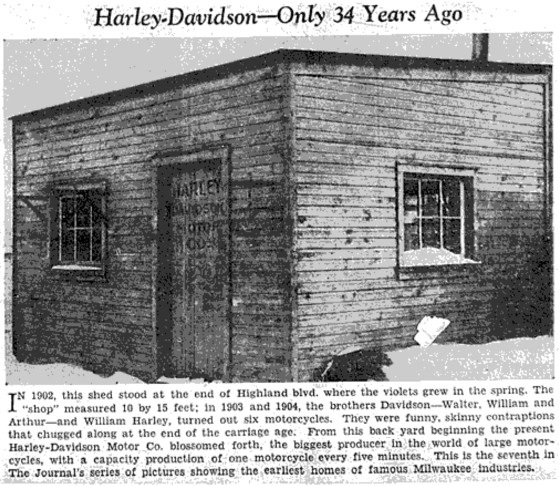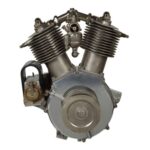It’s no secret that Harley-Davidson’s history is deeply rooted in Milwaukee. From dealerships to museums, the motorcycle giant serves as a cultural landmark and has become synonymous with the sprawling city. Thus, one may be surprised to learn of its humble beginnings. The multibillion-dollar brand began in a 10 x 15 foot shed at the corner of N. 37th St & Highland Blvd–the Davidson family’s backyard–in 1903. With production inevitably slow, the company’s expanding credibility, and increased demand in the civilian and government realm, Harley and his partners were in need of a much larger manufacturing facility. By 1910, the original Harley-Davidson motorcycle factory was born. The building, which still stands today on Juneau Ave–just one corner away from the company’s humble beginnings–allowed for the annual production of hundreds of bikes.[1] The transition represented not only the company’s first considerable expansion but also a steppingstone towards becoming the giant it is today.
The expansion of the brand coincided with the development of motorcycle racing leagues and tracks in and around Milwaukee. Walter Davidson was an avid motorcycle racer, and his successful motorcycle career played a key role in garnering the brand’s national recognition. A 1926 advertisement for the National Championship Motorcycle Races at the Wisconsin State Fair track in West Allis helped capture the excitement of the sport.[2] Due to lackluster safety protocols, rickety track construction, and the erratic nature of the bikes, many of which didn’t have brakes, racing was incredibly dangerous. However, this did not stop the sport from expanding and Harley-Davidson’s popularity from sky-rocketing. Racing continued to play a significant role in Harley’s identity, as the brand boasted hundreds of wins and accolades across the 20th and 21st centuries.



Casual riders were not the only ones attracted to the allure of Harley-Davidson. 20th century Wisconsin and beyond saw the spread of renegade counterculture and the rise of “one-percent motorcycle clubs,” which referred to the minority of riders who lived outside of the law. While gangs vary in history, identity, and outlook, many revered Harley-Davidson because of the brand’s association with American patriotism, one being the Outlaws Motorcycle Club. While the gang originated in a Chicago bar in 1935, the Milwaukee chapter gained infamy as the “Wrecking Crew” for its acts of intimidation and violence throughout the 60’s, 70’s, and 80’s. The Milwaukee chapter bore Harley-Davidson’s insignia on their jackets and adopted the low riding “chopper” model to preserve what they believed was an American image during a time when many took to cheaper Japanese bikes created by Yamaha and Kawasaki. While the notoriety and violence of the gang has since faded away, their presence is very much still felt throughout the city, as members often frequent festivals, races, and other community events.
Considering Harley-Davidson’s humble beginnings and its many cultural contributions to Milwaukee, it seemed only necessary that the brand commemorate itself in the heart of the city. 2008 marked the completion of the Milwaukee Harley-Davidson Museum. Located at 400 W Canal St, the massive 130,000 square-foot building and 20-acre lot features everything from historical exhibits to rallies and live performances. With over 300 thousand annual visitors, the landmark goes to show not only how far the brand has come but how central it is to the city.
Written by James Apter, March 2022


FOOTNOTES
[1] Wisconsin Historical Society, Wisconsin Architecture and History Inventory, Harley-Davidson Motorcycle Factory Building, Milwaukee, Wisconsin, 27894.
[2] In 1892, the Wisconsin State Fair permanently settled in West Allis. However, from 1851 until then, there have been many temporary locations, including Janesville, Watertown, Madison, and Fond du Lac. See the Wisconsin State Fair’s “History of the Wisconsin State Fair:” https://wistatefair.com/fair/history/




